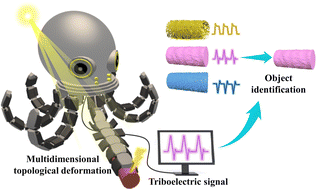Scalable multi-dimensional topological deformation actuators for active object identification†
Abstract
Rarely are bionic robots capable of rapid multi-dimensional deformation and object identification in the same way as animals and plants. This study proposes a topological deformation actuator for bionic robots based on pre-expanded polyethylene and large flake MXene, inspired by the octopus predation behavior. This unusual, large-area topological deformation actuator (easily reaching 800 cm2 but is not constrained to this size) prepared by large-scale blow molding and continuous scrape coating exhibits different distribution states of molecular chains at low and high temperatures, causing the actuator's deformation direction to change axially. With its multi-dimensional topological deformation and self-powered active object identification capabilities, the actuator can capture objects like an octopus. The contact electrification effect assists the actuator to identify the type and size of the target object during this multi-dimensional topological deformation that is controllable and designable. This work demonstrates the direct conversion of light energy into contact electrical signals, introducing a new route for the practicality and scaling of bionic robots.



 Please wait while we load your content...
Please wait while we load your content...